Gasteria Succulents: 33 Varieties and Care Tips
Gasteria succulents are an extraordinary and rare type of plant that you may not be familiar with. Originating from South Africa, these compact and easy-to-grow succulents are a true delight for any succulent enthusiast. Despite the common misconception that gasterias are related to aloes or haworthias, they actually belong to their own distinct genus. In this article, we will explore the wonderful world of gasteria succulents, including their different types, unique characteristics, and important care tips.
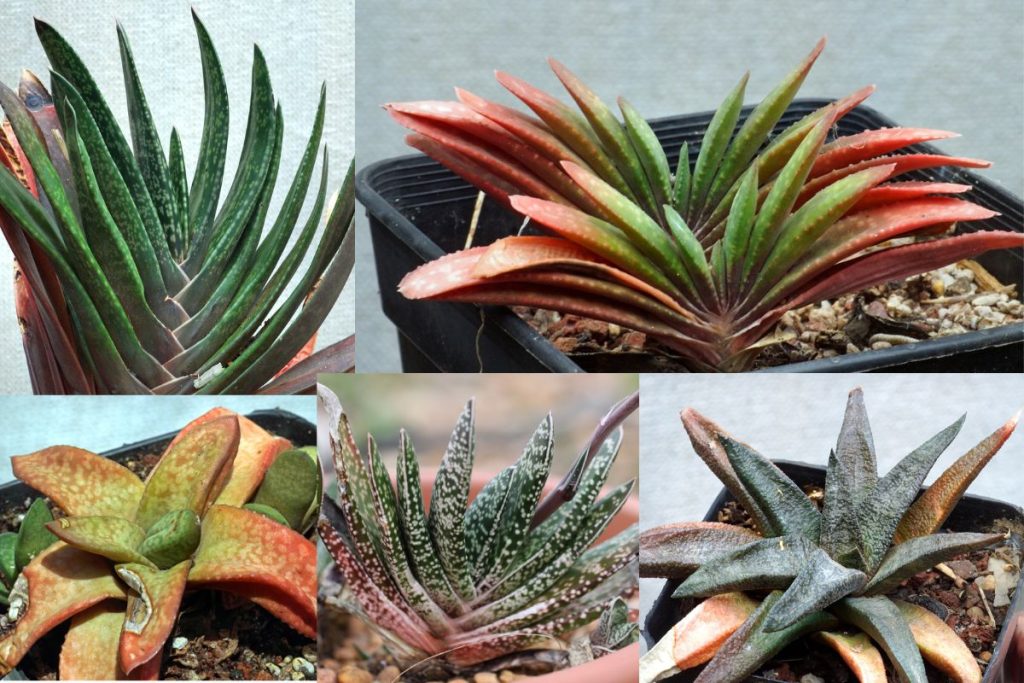
Gasteria succulents are a diverse group of plants, which can make describing them a bit challenging. Their appearance can vary depending on factors like location, soil, and age. It’s worth noting that young plants may look quite different from mature ones. Additionally, gasterias can easily crossbreed, resulting in hybrids with unique characteristics.
In terms of size, gasterias can range from as small as 1 inch to 12 inches in diameter to several feet in height. So, you can find gasterias that are as petite as haworthias or as tall as aloes.
Interestingly, the name “gasteria” comes from the Greek word for stomach, “gaster,” because of the shape of their flowers. However, it’s worth mentioning that the flower appearance can vary to some extent among different gasteria species, making identification a bit tricky. Luckily, there are around 16 to 23 known species of gasterias, narrowing down the options.
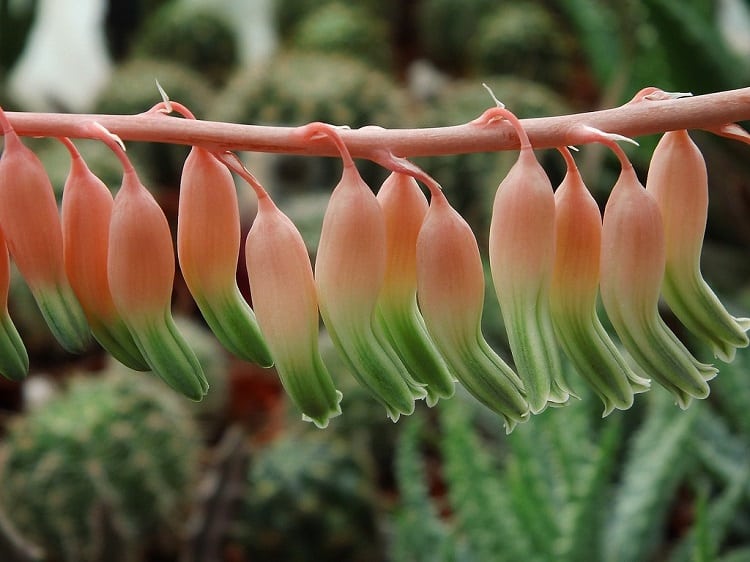
Contents
- 1 Types of Gasteria Succulents
- 1.1 Gasteria acinacifolia
- 1.2 Gasteria batesiana
- 1.3 Gasteria baylissiana
- 1.4 Gasteria bicolor
- 1.5 Gasteria bicolor var. fallax
- 1.6 Gasteria bicolor var. liliputana
- 1.7 Gasteria brachyphylla
- 1.8 Gasteria brachyphylla var. bayeri
- 1.9 Gasteria camillae
- 1.10 Gasteria carinata
- 1.11 Gasteria carinata var. glabra
- 1.12 Gasteria carinata var. verrucosa
- 1.13 Gasteria croucheri
- 1.14 Gasteria croucheri subsp. pendulifolia
- 1.15 Gasteria disticha
- 1.16 Gasteria disticha var. langebergensis
- 1.17 Gasteria doreeniae
- 1.18 Gasteria ellaphieae
- 1.19 Gasteria excelsa
- 1.20 Gasteria glauca
- 1.21 Gasteria glomerata
- 1.22 Gasteria loedolffiae
- 1.23 Gasteria ‘Little Warty’
- 1.24 Gasteria nitida
- 1.25 Gasteria nitida subsp. armstrongii
- 1.26 Gasteria pillansii
- 1.27 Gasteria pillansii var. ernesti-ruschii
- 1.28 Gasteria pillansii var. hallii
- 1.29 Gasteria polita
- 1.30 Gasteria pulchra
- 1.31 Gasteria rawlinsonii
- 1.32 Gasteria tukhelensis
- 1.33 Gasteria vlokii
- 2 How to Care for Gasteria Types
- 3 Propagating Gasteria Succulents
Types of Gasteria Succulents
If you’re curious about the different kinds of succulents you have, this article will help you identify Gasteria succulents, including both common and rare varieties.
Related Post:
1,000 Types of Succulents with Pictures
Gasteria acinacifolia
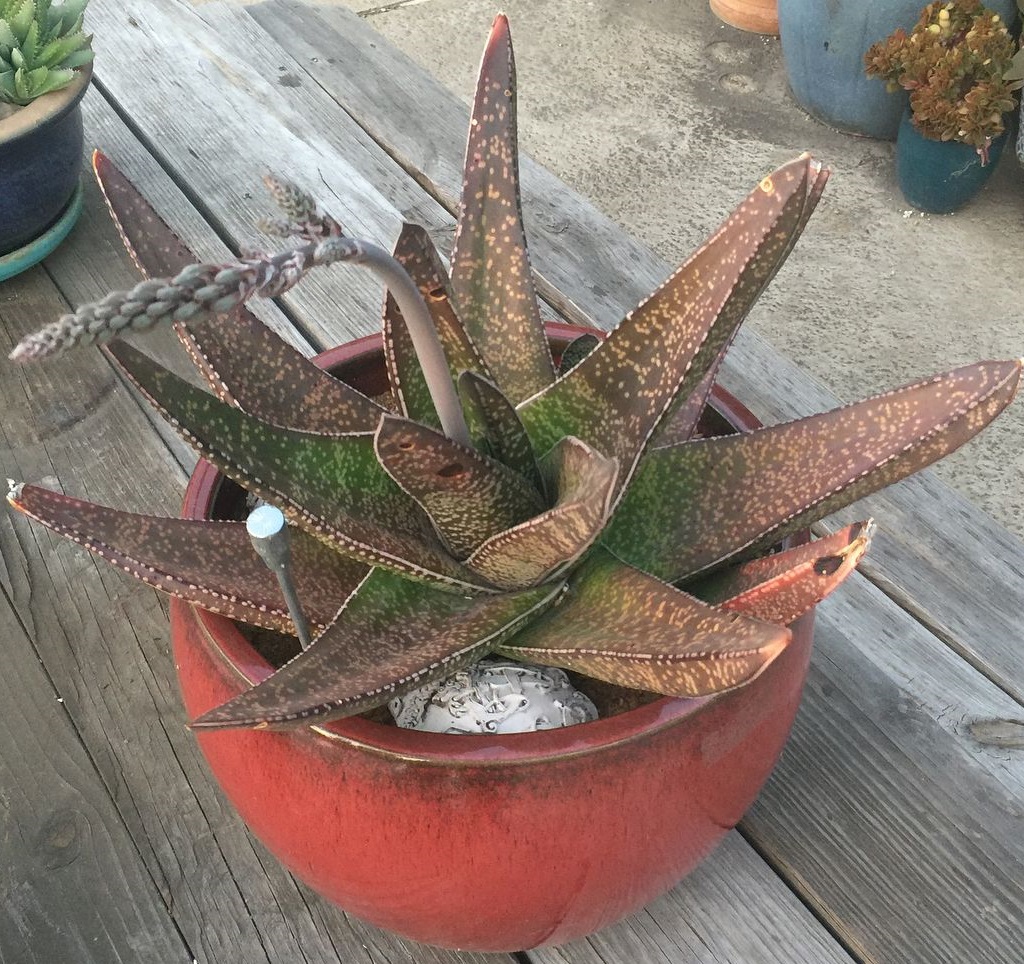
This species stands out among the 21 recognized species of Gasterias due to its large size and abundant nectar production, which attracts many bird species during its blooming period in spring. Gasteria acinacifolia has elongated, lanceolate leaves that form a rosette shape, with about 10 to 20 leaves arranged distally. Its color ranges from dark green to white-spotted, and its tubular flowers come in a variety of colors, including orange, green, red, pink, or cream.
Gasteria batesiana
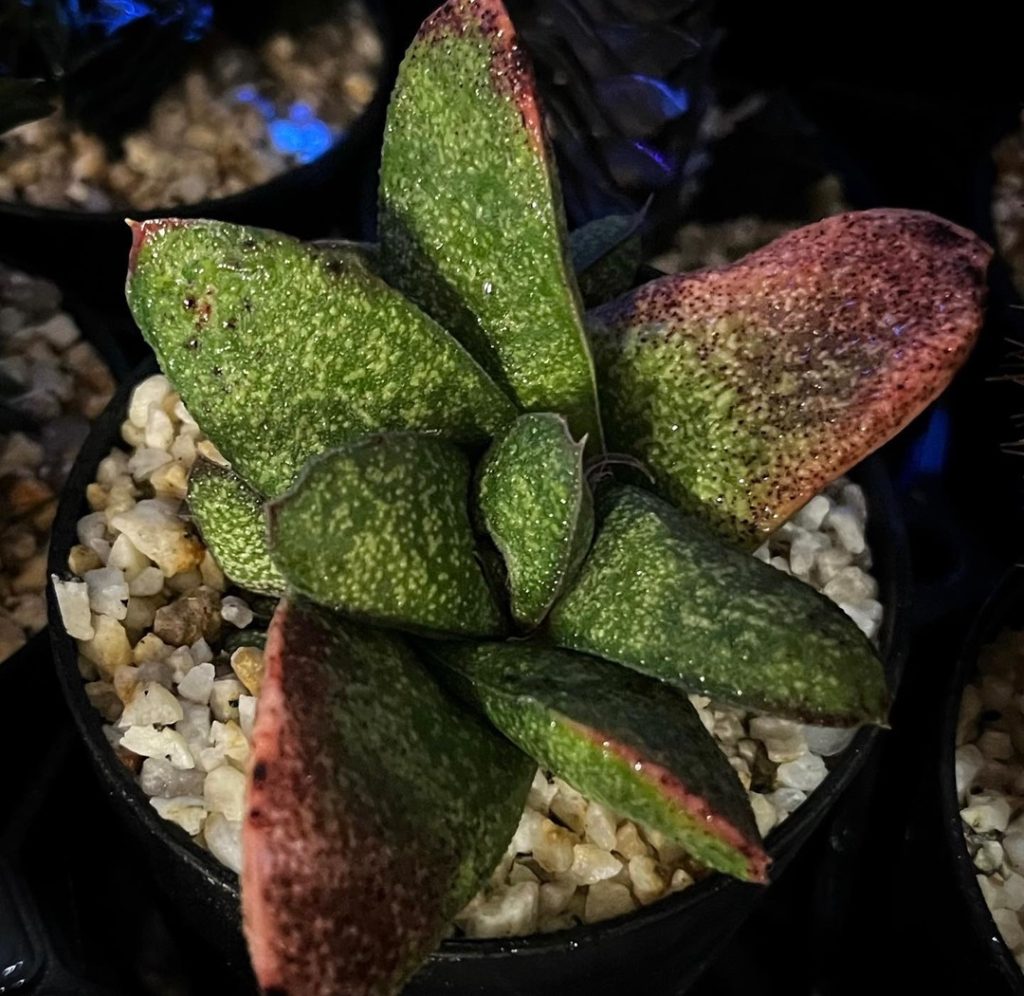
Gasteria batesiana is a stemless plant that grows in rosette form with lanceolate triangular leaves. At around 5 inches in height and 12 inches in diameter, this succulent has an intense green color with small bumps resembling warts. In autumn, it produces flowers, although their ornamental value may not be as remarkable as other aspects of the plant.
Gasteria baylissiana
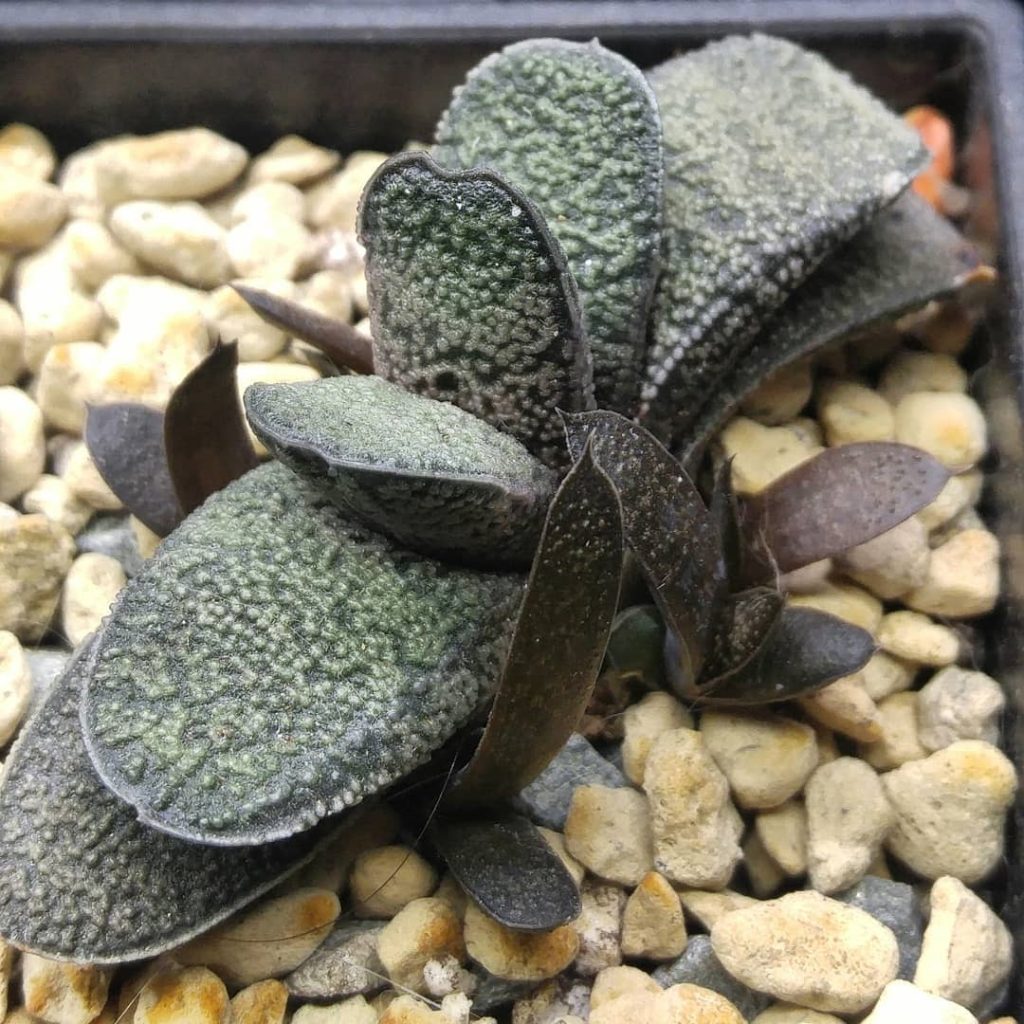
Gasteria baylissiana is a small, aloe-like succulent with dwarf, succulent leaves in a stemmed cluster. It is a popular variety that thrives in cultivation. The leaves grow in two vertical rows, with a leathery texture and dense white tubercles. The plant is found in the northwestern corner of the Addo Elephant National Park in the Eastern Cape Province.
Gasteria bicolor
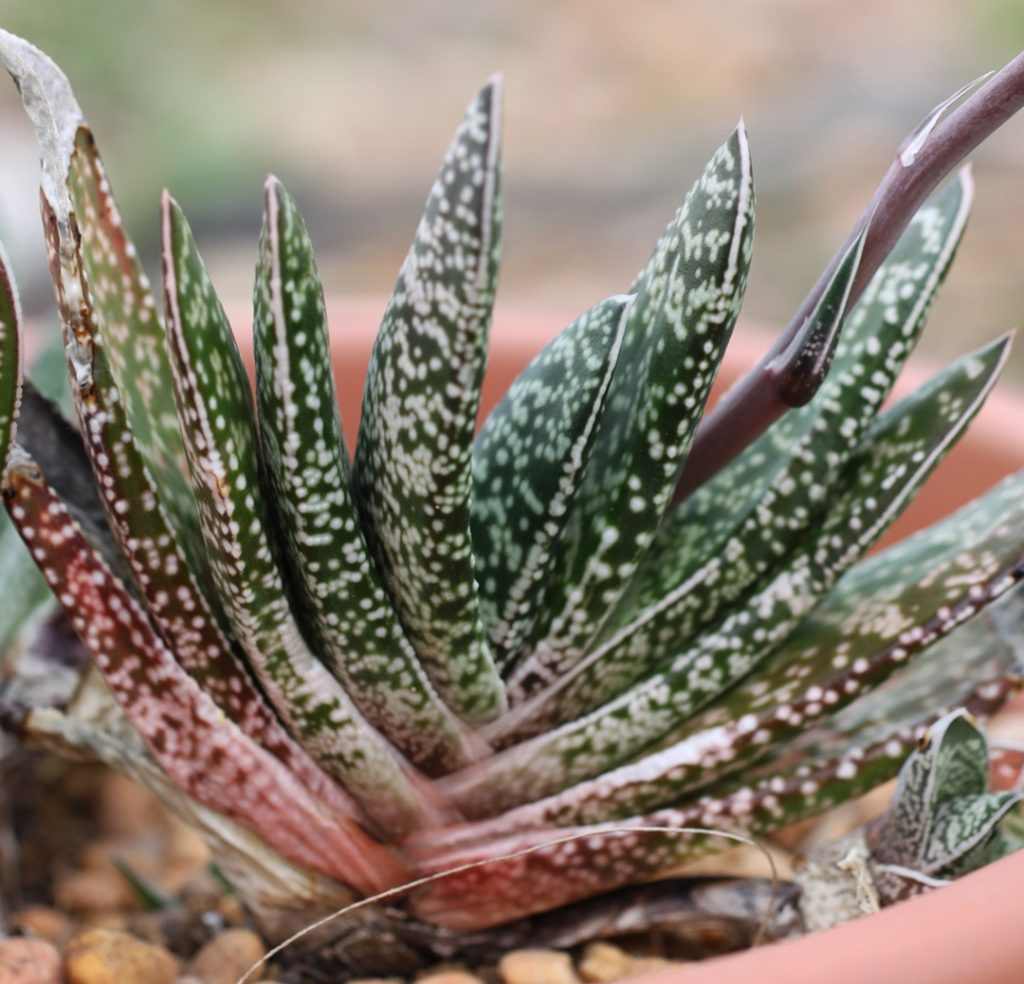
Gasteria bicolor, also known as Gasteria maculata and Gasteria obliqua, is a unique species that forms long, leafy stems instead of basal rosettes. It can grow up to 20-28 inches tall and 3 feet in diameter, with leaves that are 4.7-11.8 inches long and 0.6-1.4 inches wide. The leaves are dark green or glaucous green, with minimal or mottled cream spots arranged in transverse lines. The flowers are small, tubular, and bicolored, ranging from reddish-pink to green.
Gasteria bicolor var. fallax
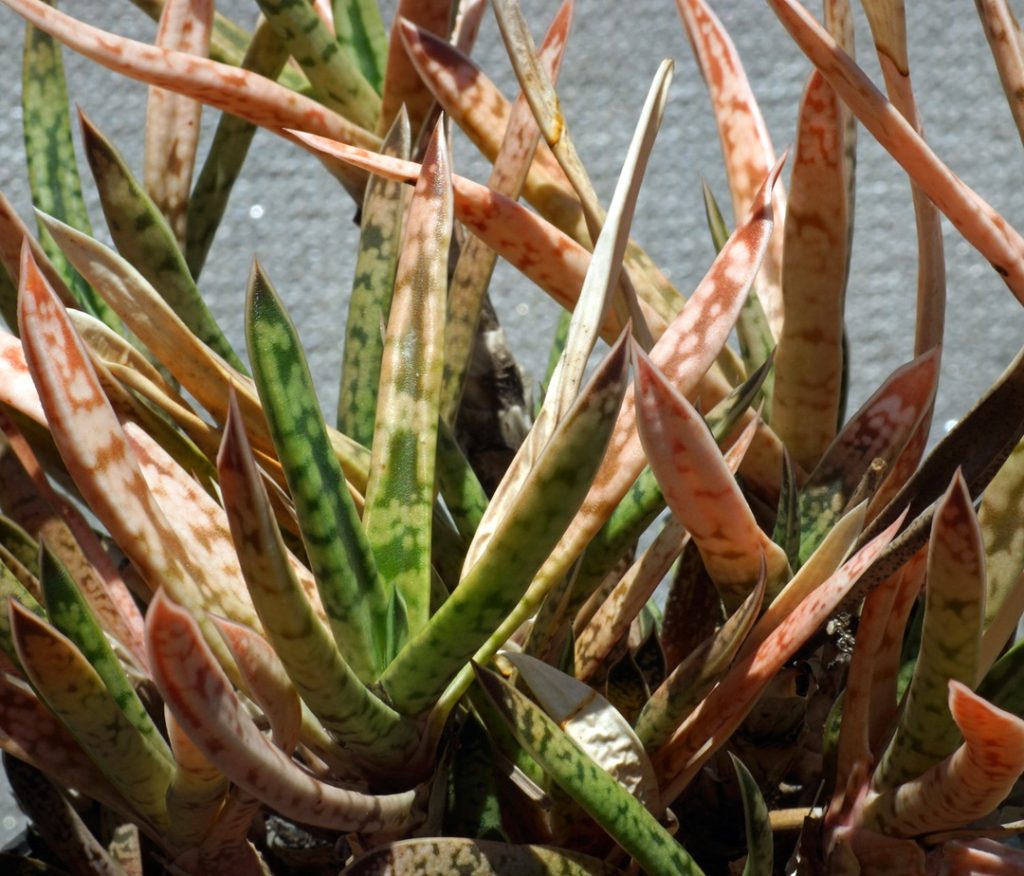
Gasteria bicolor var. fallax is known for its narrow, elongated, mottled leaves that are approximately 5.5 inches long and 0.4 inches wide. These plants form dense clumps and are mainly found in the Albany thickets near Swartwaterspoort.
Gasteria bicolor var. liliputana
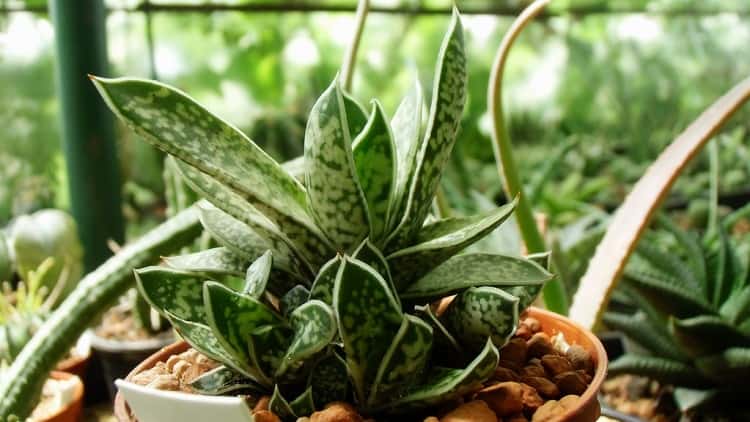
Gasteria liliputana is one of the smallest Gasteria species. Its pointed-lanceolate leaves are only 1.2-2.8 inches long and approximately 0.6 inches wide. The leaves are arranged in spiral rosettes and have a dark green color that may be mottled with whitish spots. The underside of the leaves is keel-shaped.
Gasteria brachyphylla
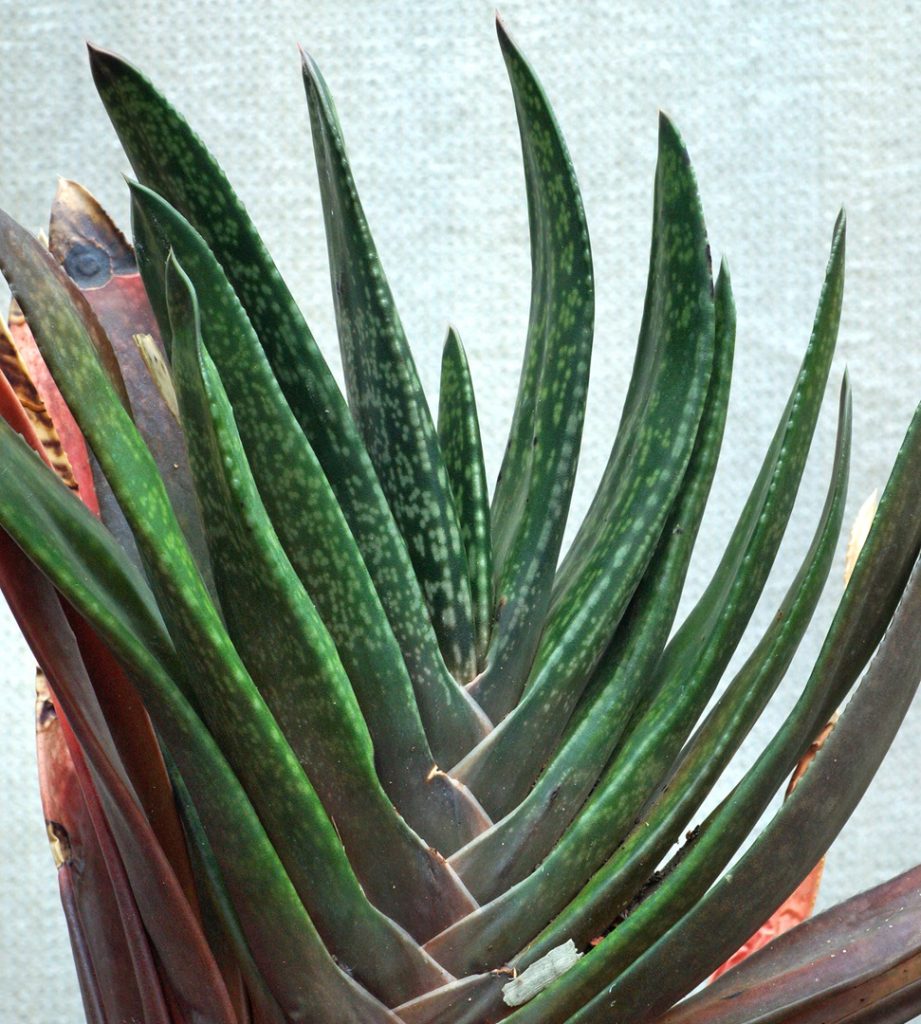
Gasteria brachyphylla forms pointed, tongue-shaped leaves that are about 6 inches long and 1 inch wide. The dark green colored leaves of Gasteria brachyphylla, decorated with numerous white spots, are about 6 inches long and 1 inch wide. At the base, these leaves are almost horizontal and curve upwards towards the end of the leaf.
Gasteria brachyphylla var. bayeri
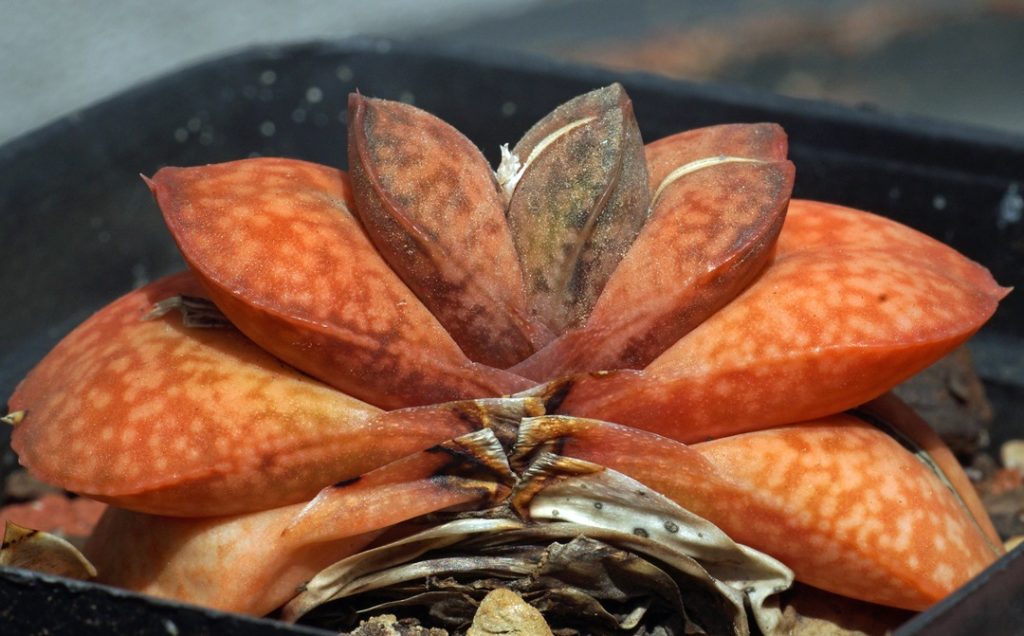
This variety of Gasteria brachyphylla is smaller, with leaves only 0.6-2 inches long and truncated leaf-ends. The inflorescence can grow up to 11 inches long, and the flowers are large for such a small plant, measuring about 0.7 inches.
Gasteria camillae
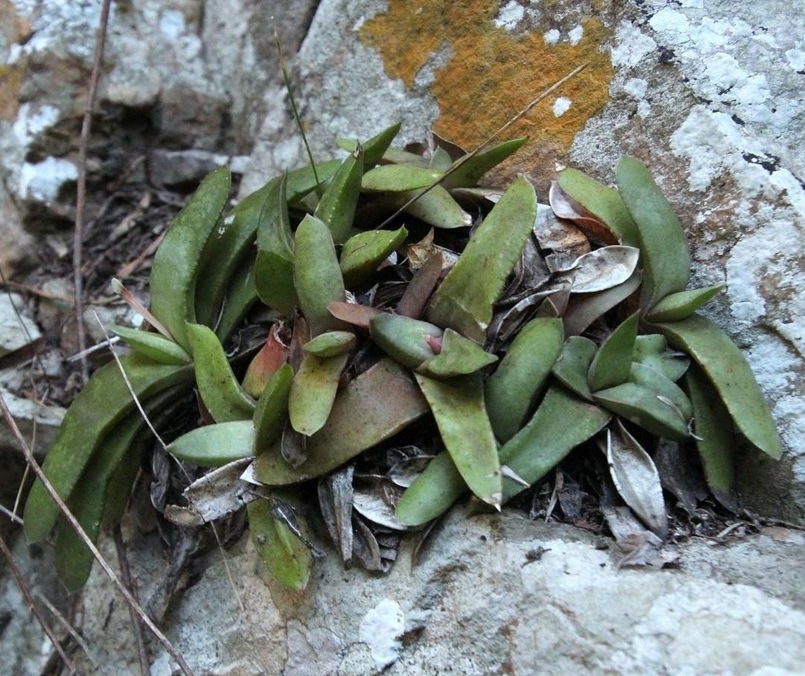
Gasteria camillae is a slow-growing, dwarf succulent with light grey-green, spreading to recurved leaves in rosettes. It is a popular plant that thrives in cultivation. The rosettes can grow up to 6.7 inches in diameter, with stems up to 6.7 inches long. The leaves are 1.6-2.8 inches long and 0.8-1 inch wide, with a distinct vertical arrangement on opposite sides of the stem. The leaf ends are blunt but have a small hard point.
Gasteria carinata
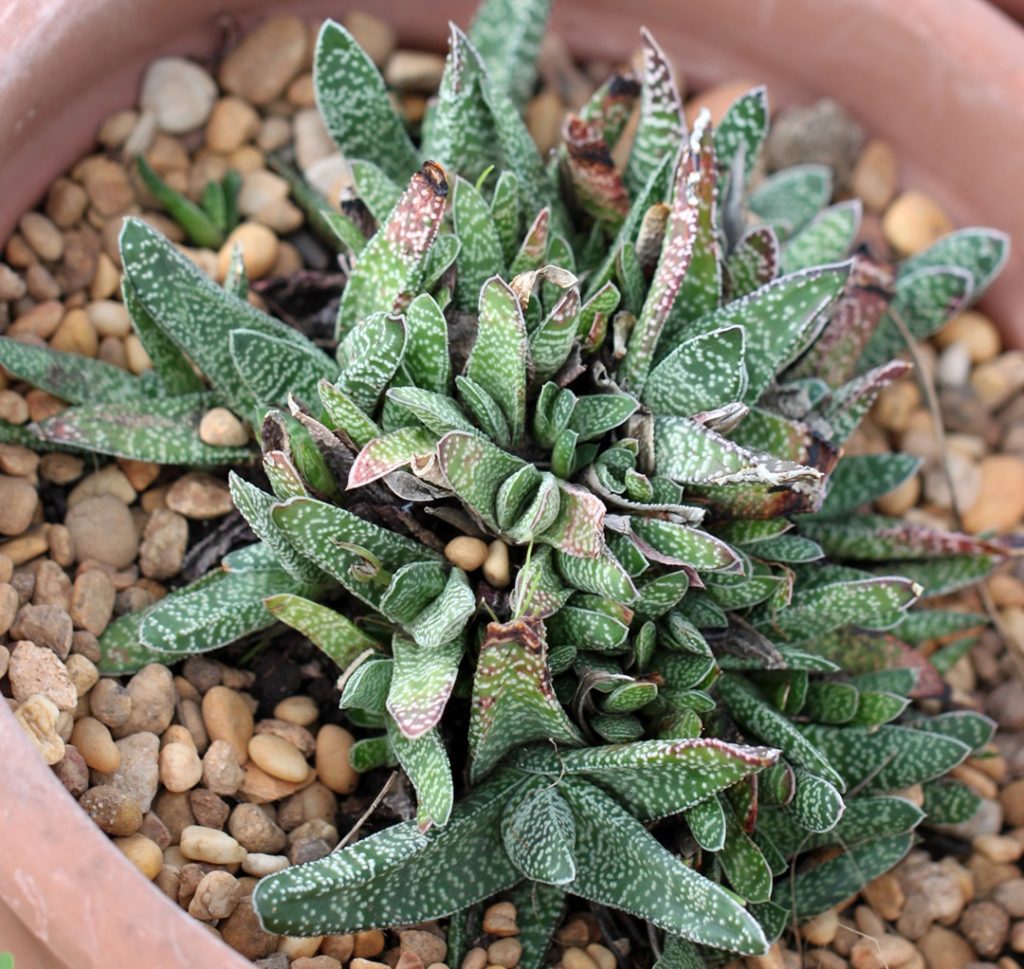
Gasteria carinata is a stemless succulent with strap-shaped leaves that are dark green and spotted with white tubercles. The leaves can reach up to 8 inches long and 0.8 inches wide. During summer, it produces pinkish flowers in a lax cluster arrangement.
Gasteria carinata var. glabra
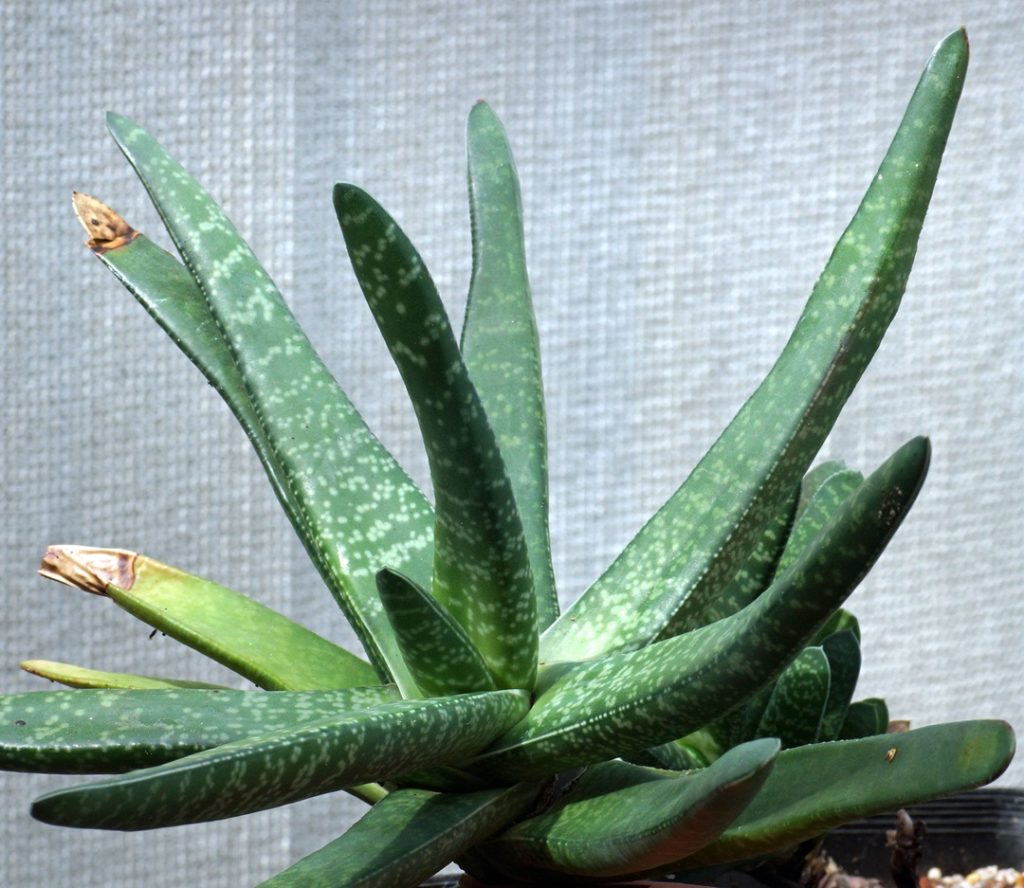
This variety of Gasteria carinata has smooth leaves without the usual tubercles. It is mainly found in the eastern portion of its distribution area.
Gasteria carinata var. verrucosa
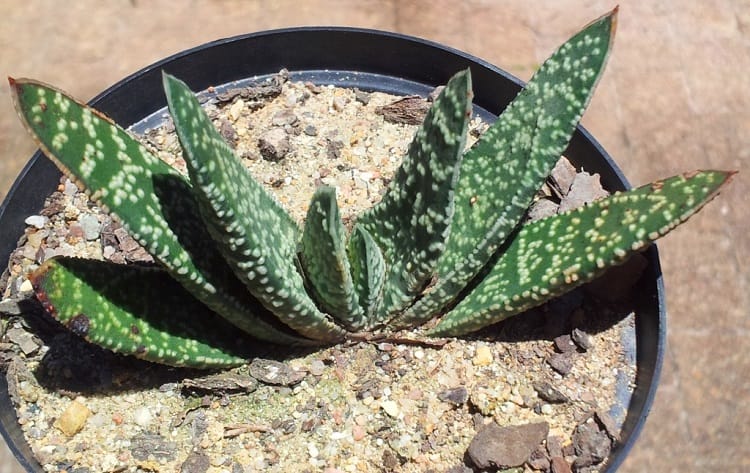
Gasteria carinata var. verrucosa is a small succulent with leaves that are about 6 inches long and 0.4 inches wide. Its leaves are mottled and covered in small, whitish warts. It is native to South Africa.
Gasteria croucheri
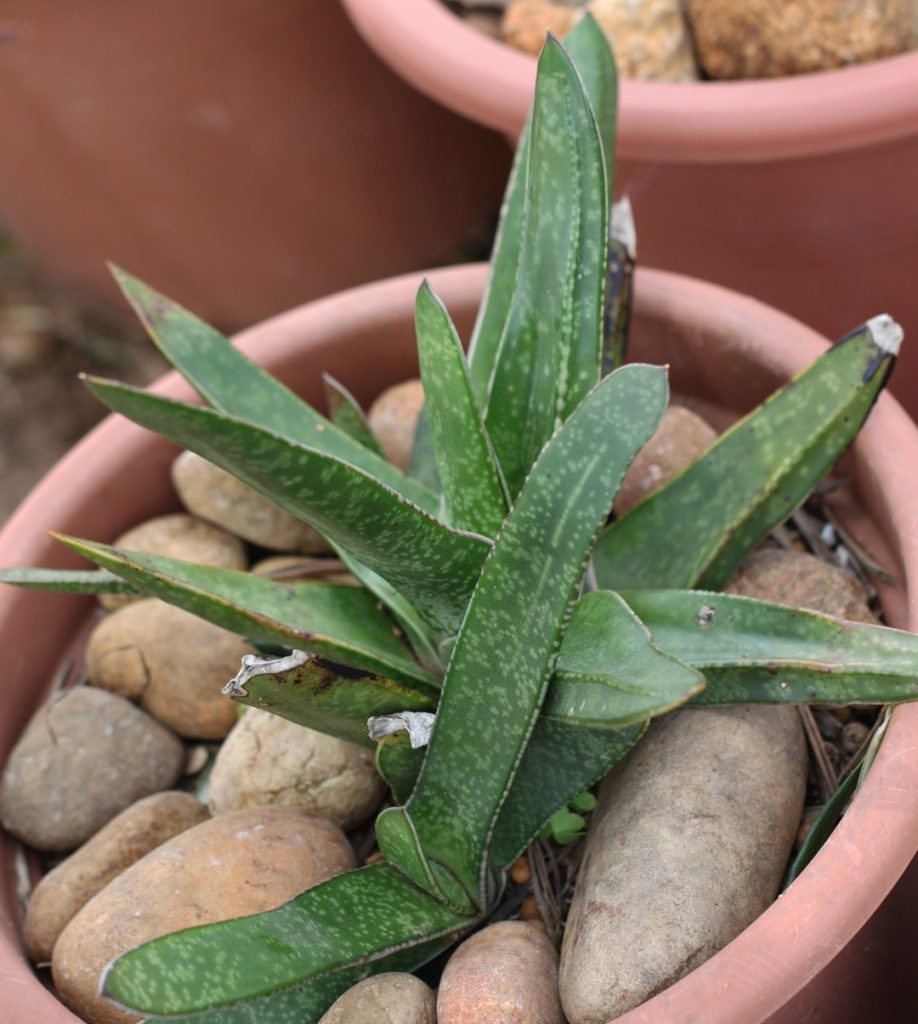
Gasteria croucheri is a slow-growing succulent with ascending, spreading leaves. It forms small clusters and can reach a height of up to 16 inches. The leaves are lanceolate and have a rough texture.
Gasteria croucheri subsp. pendulifolia
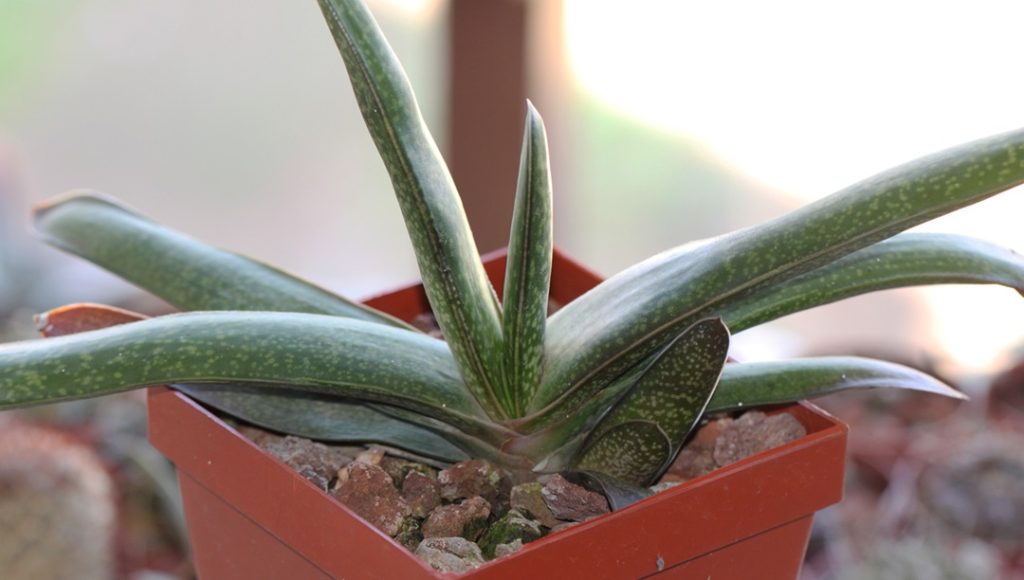
This subspecies of Gasteria croucheri is a medium-sized clustering plant with leaves that can grow up to 1 foot long. Its inflorescence is several feet long and branches out, giving rise to multiple pink, pendulous flowers.
Gasteria disticha
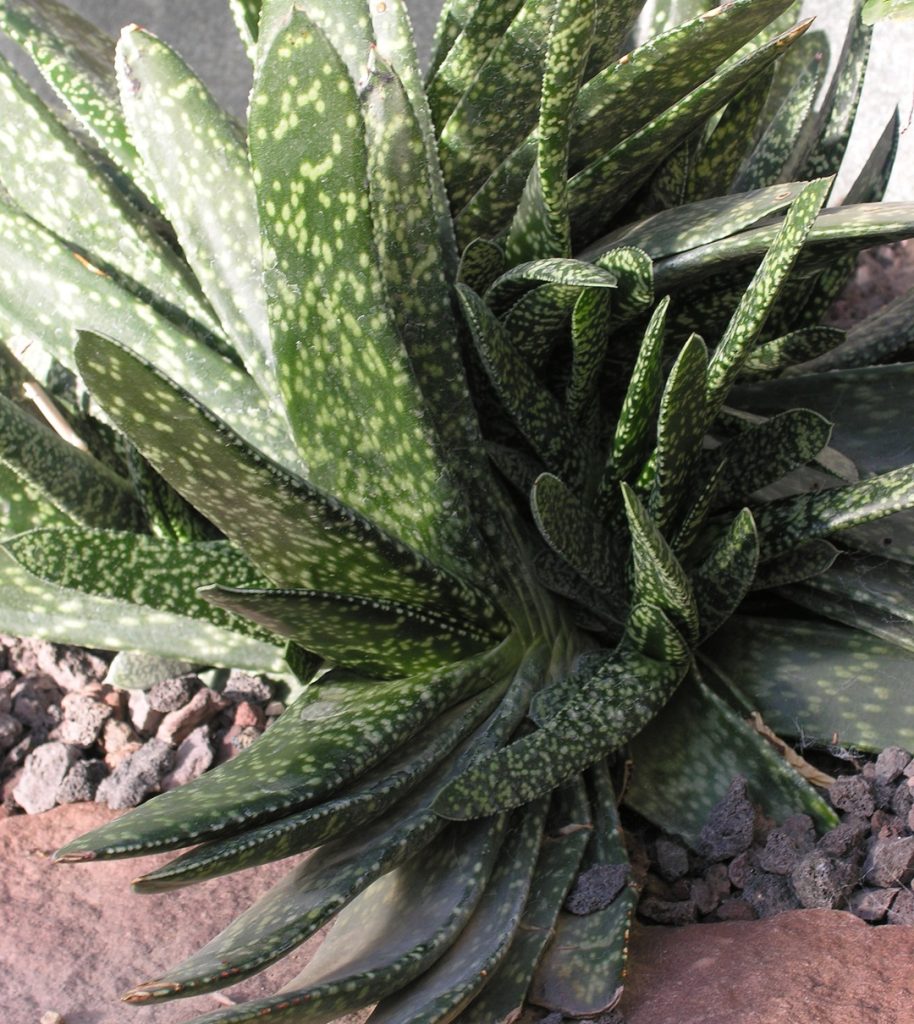
Gasteria disticha is a small succulent plant, with leaves growing in two opposite rows or in a spiral arrangement around the stem. The leaves can reach up to 4.7-7.5 inches long and 1.2-1.6 inches wide at the base. They have a triangular to triangular-oblong shape and can be slightly sickle-shaped or without a keel. The leaves are dark green with dense white spots arranged in transverse bands.
Gasteria disticha var. langebergensis
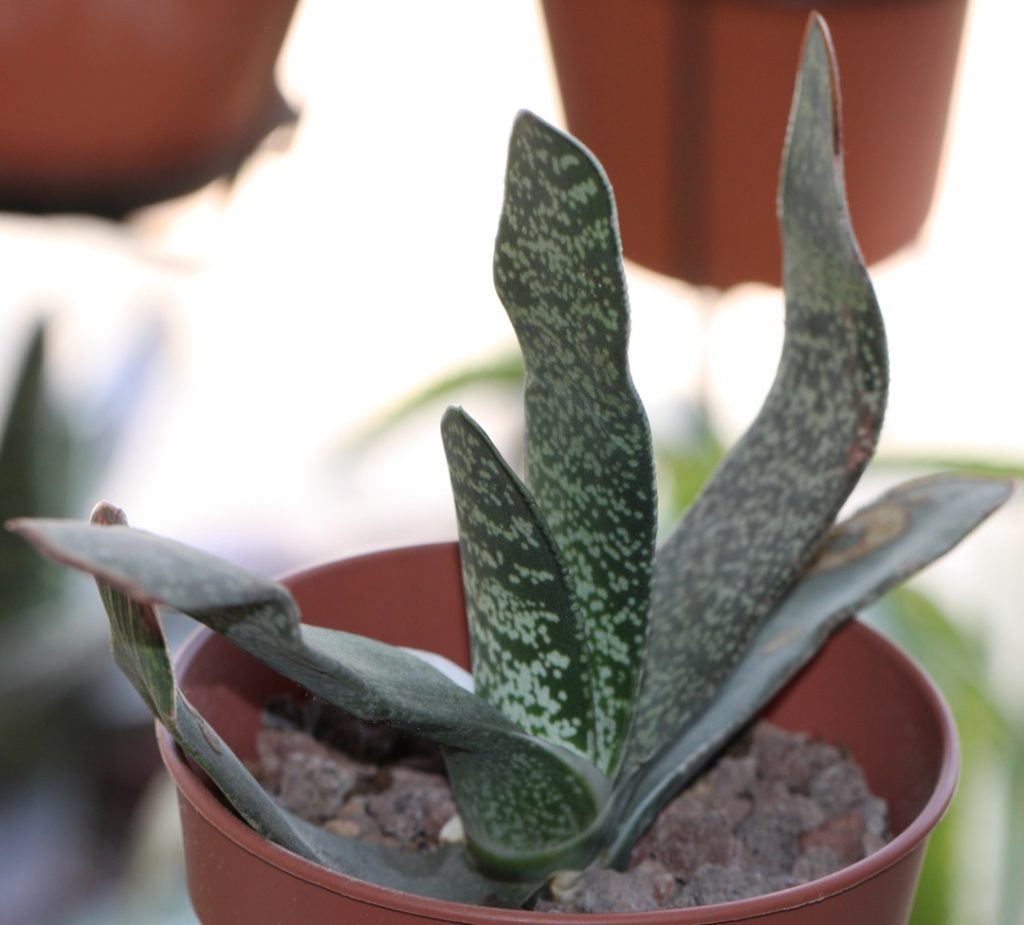
Gasteria disticha var. langebergensis is a dense clumping succulent. It forms small clusters and grows up to 6 inches tall. The leaves are narrow, elongated, and mottled, measuring approximately 5.5 inches long and 0.4 inches wide.
Gasteria doreeniae
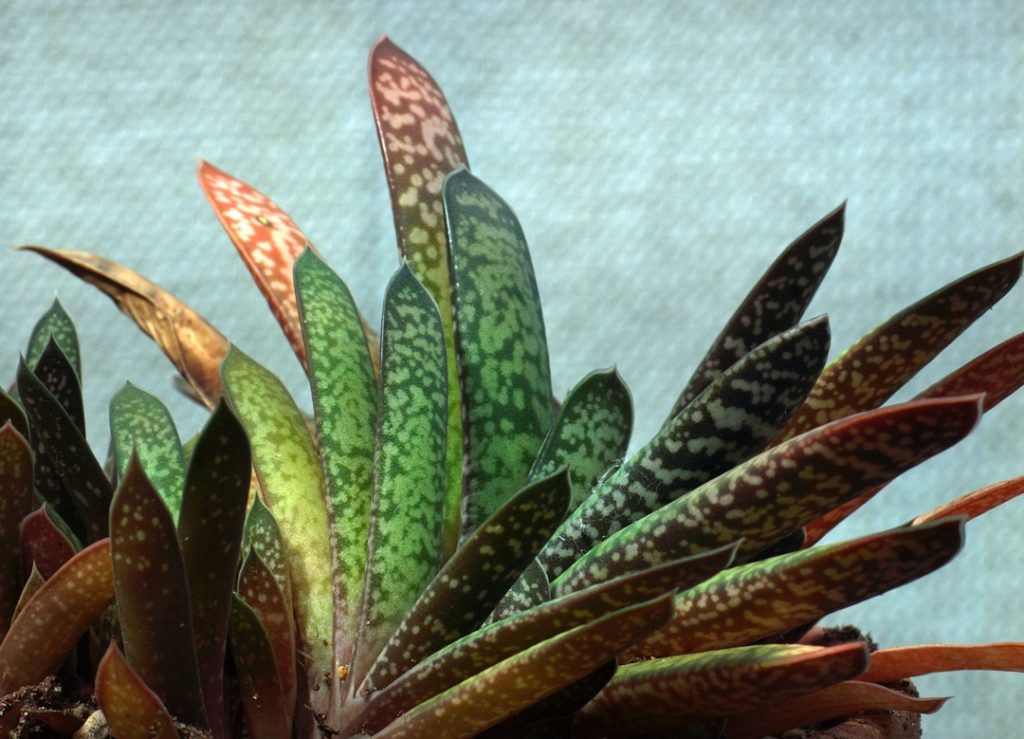
Gasteria doreeniae is a dwarf, aloe-like succulent that grows in clusters. It has light grey-green, spreading to recurved leaves that proliferate from the base. The raceme of orange-pink, pendent flowers appears in the early summer.
Gasteria ellaphieae
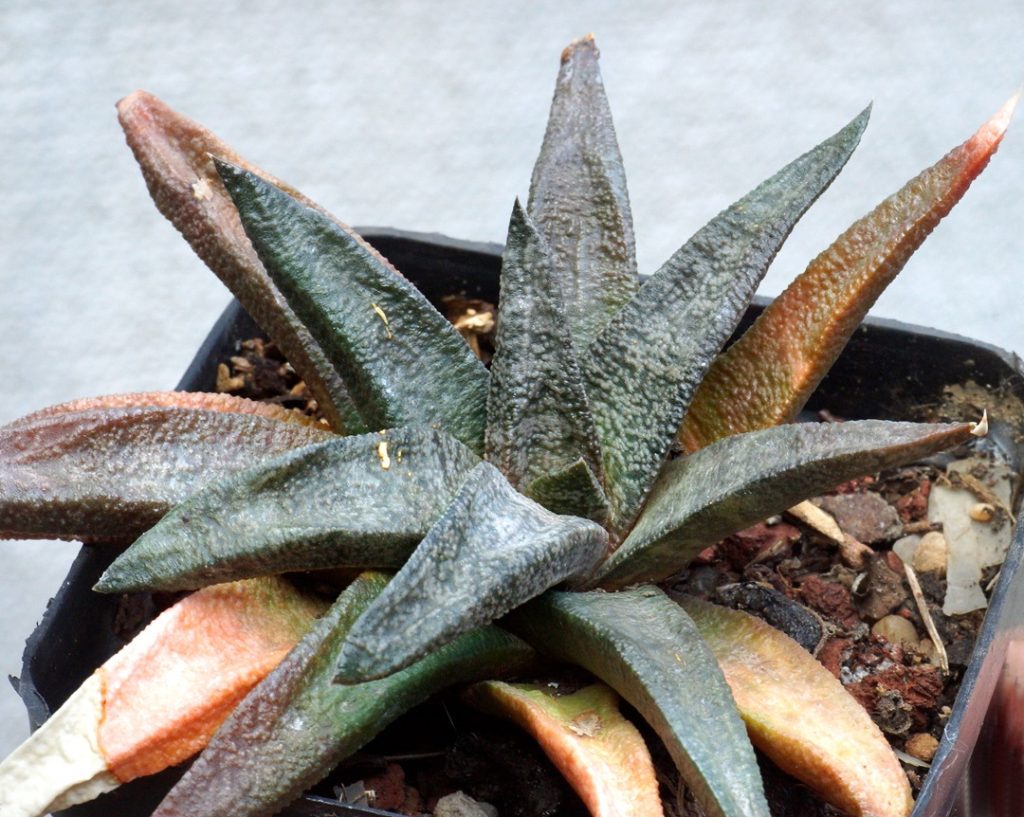
Gasteria ellaphieae is a small succulent with propeller-shaped rough leaves. It is stemless and forms dense ascending clusters. The leaves are thick, rough-textured, triangular-lanceolate, and marbled in appearance.
Gasteria excelsa
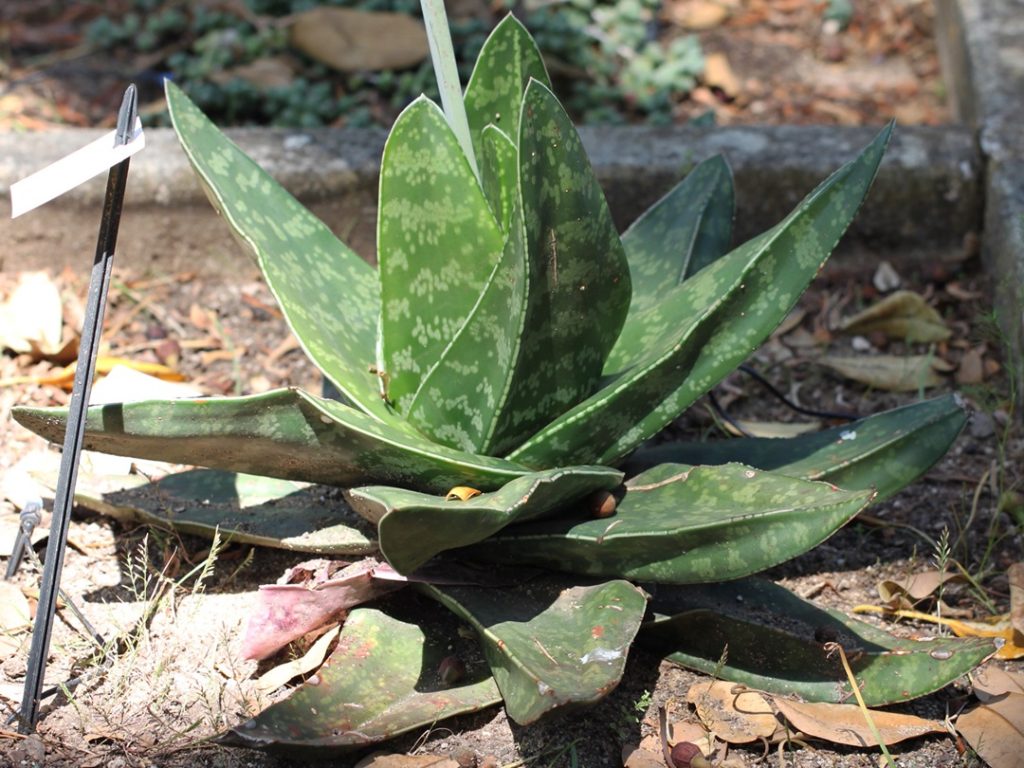
Gasteria excelsa is a medium-sized aloe-like plant that can reach a height of 16-28 inches and a width of up to 16 inches. It has triangular, spreading, ascending leaves that are dark-mottled green in color. During summer, it produces a dense panicle of pinkish flowers.
Gasteria glauca
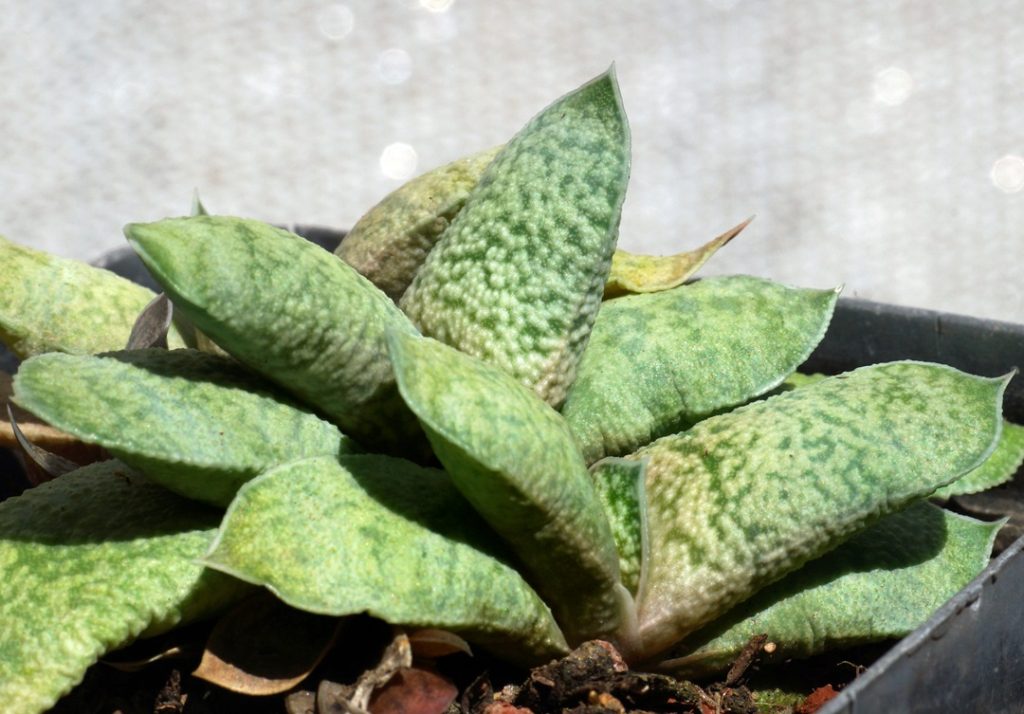
Gasteria glauca is a small aloe-like plant with highly succulent, glaucous (grey-green) leaves arranged in a dense rosette. It can reach a height of 4-8 inches and a width of 6 inches. The leaves are narrow and finger-like, tapering to a sharper point. They are densely blotched with white, giving them a marbled appearance.
Gasteria glomerata
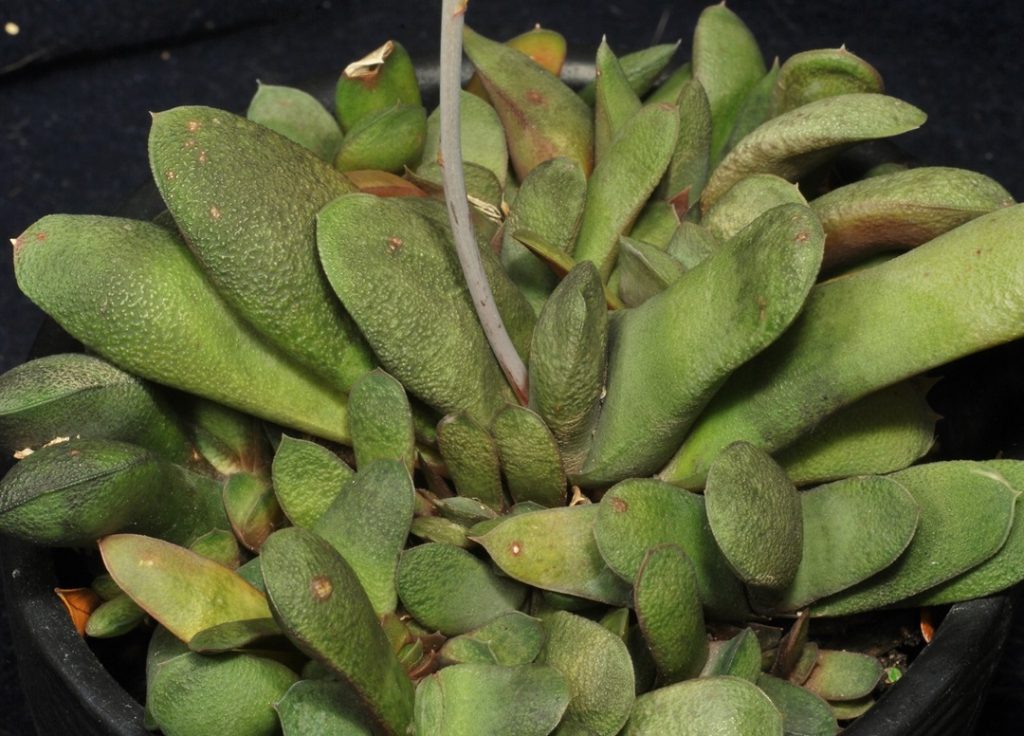
Gasteria glomerata is a stemless succulent plant that grows in rounded clusters, reaching sizes of 0.8-2 inches in diameter. The fat, strap-shaped leaves are grey-green or glaucous, and the rosettes consist of up to 15 leaves arranged in a distichous pattern. The leaves are rough in texture and covered in small warty bumps. The inflorescence is a spreading raceme, up to 8 inches long, with small, dainty, tubular flowers in orange or pinkish-red colors hanging gracefully.
Gasteria loedolffiae
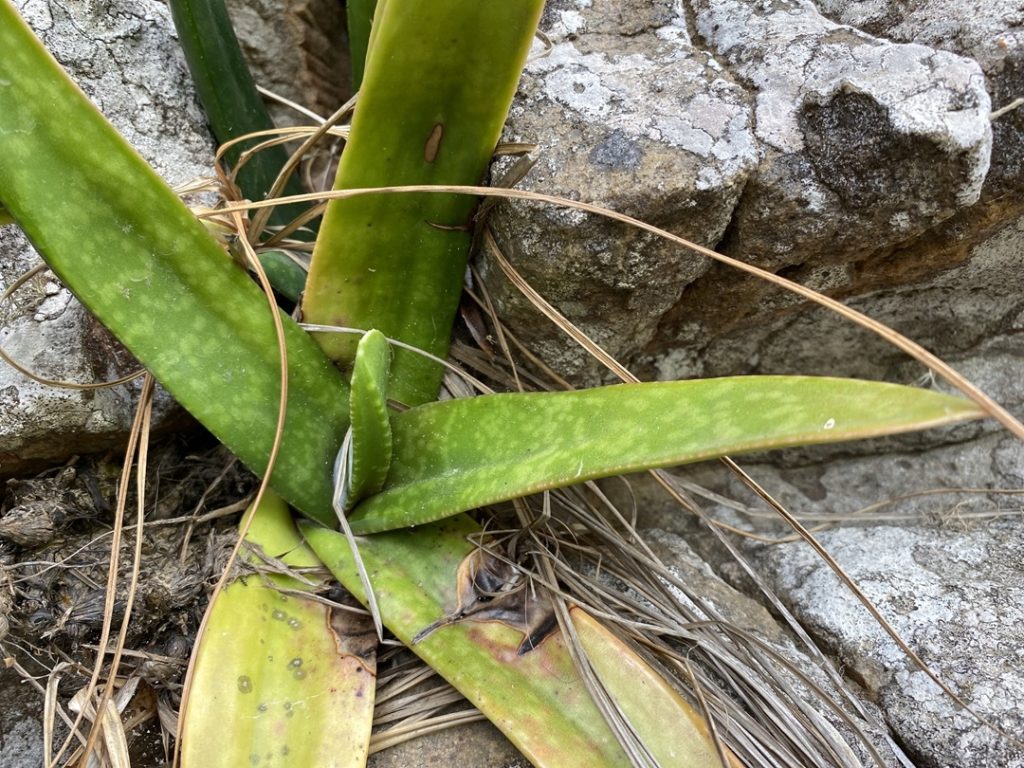
Gasteria loedolffiae is a small aloe-like plant that grows in solitary specimens or forms small groups on sheer shale cliffs. It can reach heights of up to 8 inches and widths of up to 6.3 inches. The leaves are grey-green, triangularly strap-shaped, and curving upwards or backwards. They have a leathery texture and are covered in white tubercles. The plants produce dark pink flowers in summer.
Gasteria ‘Little Warty’
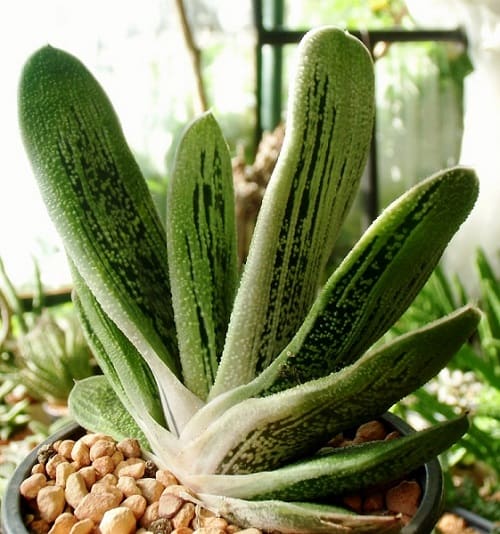
Gasteria ‘Little Warty’ is a small succulent species with charming leaves. They are thick, firm, and deep green in color, with white bumps resembling warts. This variety is highly sought after and admired for its unique appearance.
Gasteria nitida
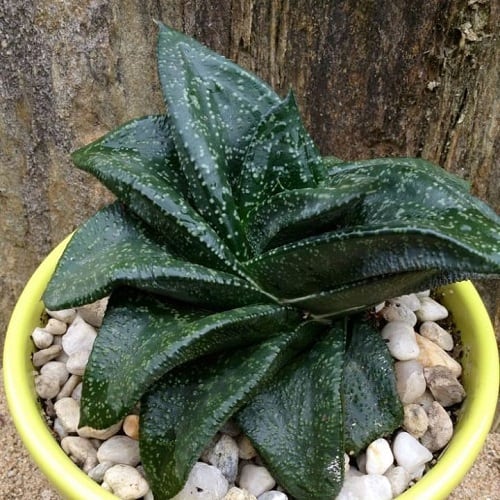
Gasteria nitida is a medium-sized succulent with banded leaves. It thrives in cultivation and grows well in containers or on a rockery. The leaves are triangular, spreading, and ascending, with dark-mottled green coloration.
Gasteria nitida subsp. armstrongii
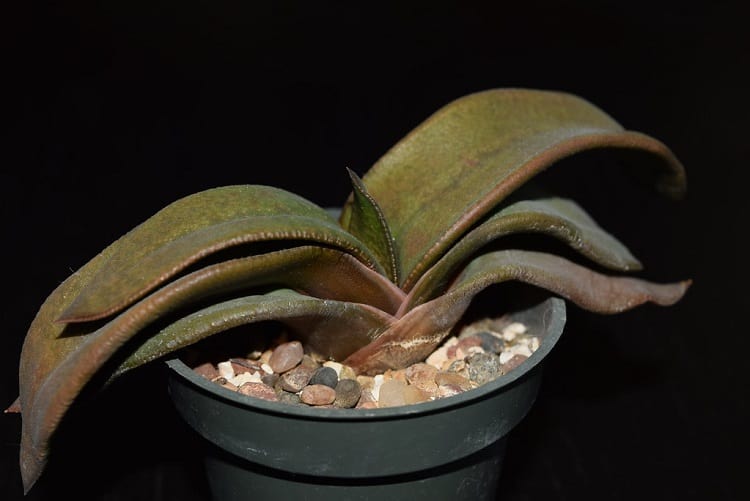
Gasteria nitida subsp. armstrongii is a small clustering variety with smooth leaves that are smaller than the standard species (up to 1.2 inches long). The inflorescence can grow up to 11 inches long, and the flowers are large for such a small plant.
Gasteria pillansii
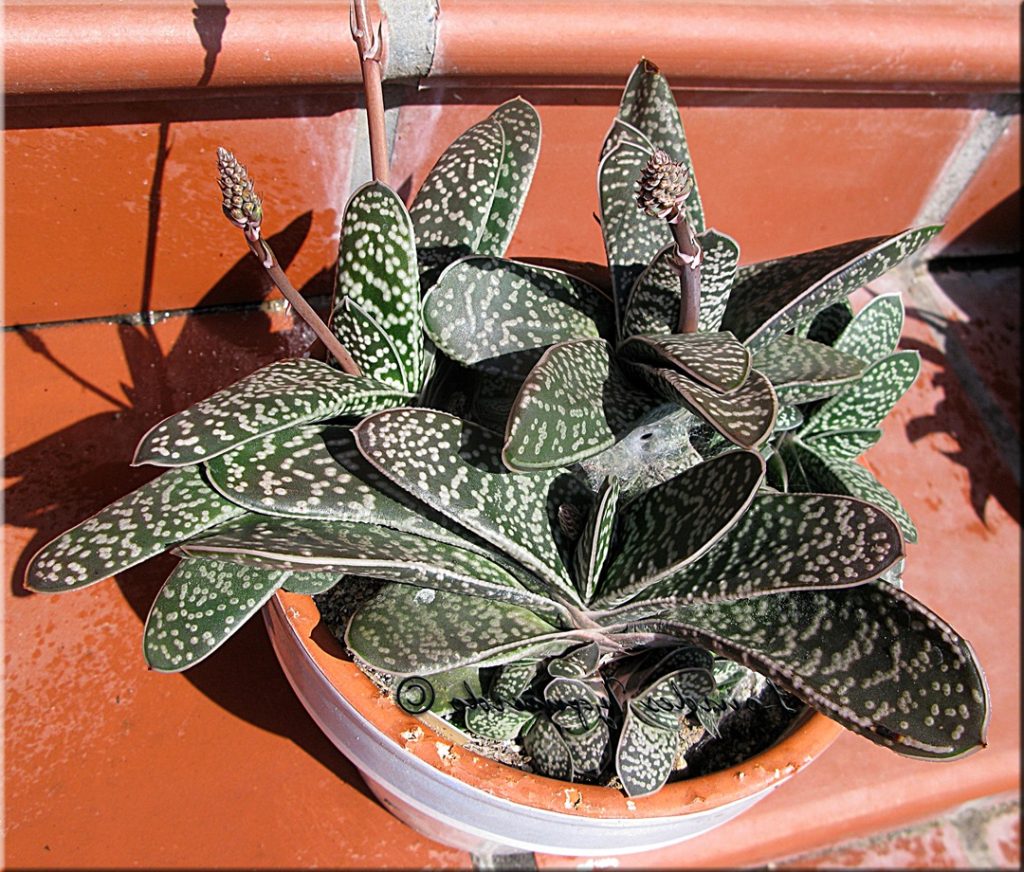
Gasteria pillansii is a stemless succulent with strap-shaped leaves that can reach up to 8 inches in length and 2 inches in width. The leaves are rough and tuberculate, and the plant can form dense clusters.
Gasteria pillansii var. ernesti-ruschii
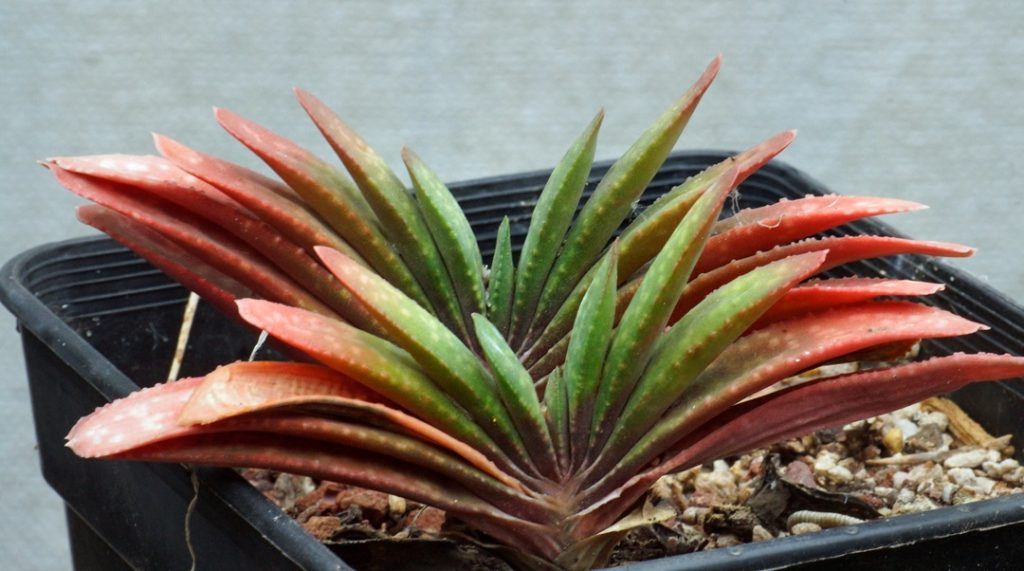
Gasteria pillansii var. ernesti-ruschii is a dwarf form of the standard species, with smaller leaves measuring less than 2.4 inches in length. It forms clusters and is found in the Knersvlakte region.
Gasteria pillansii var. hallii
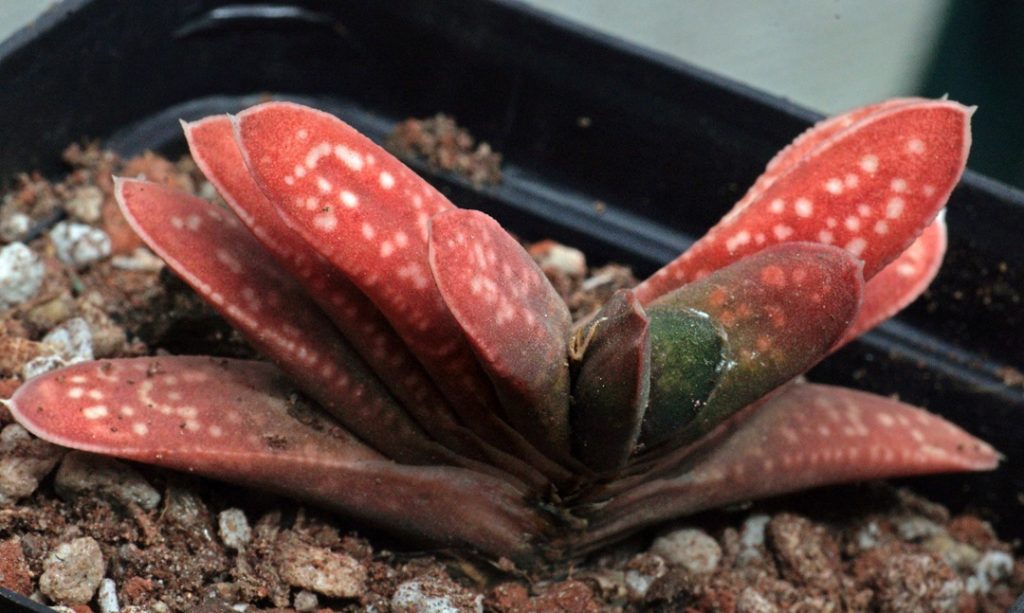
Gasteria polita
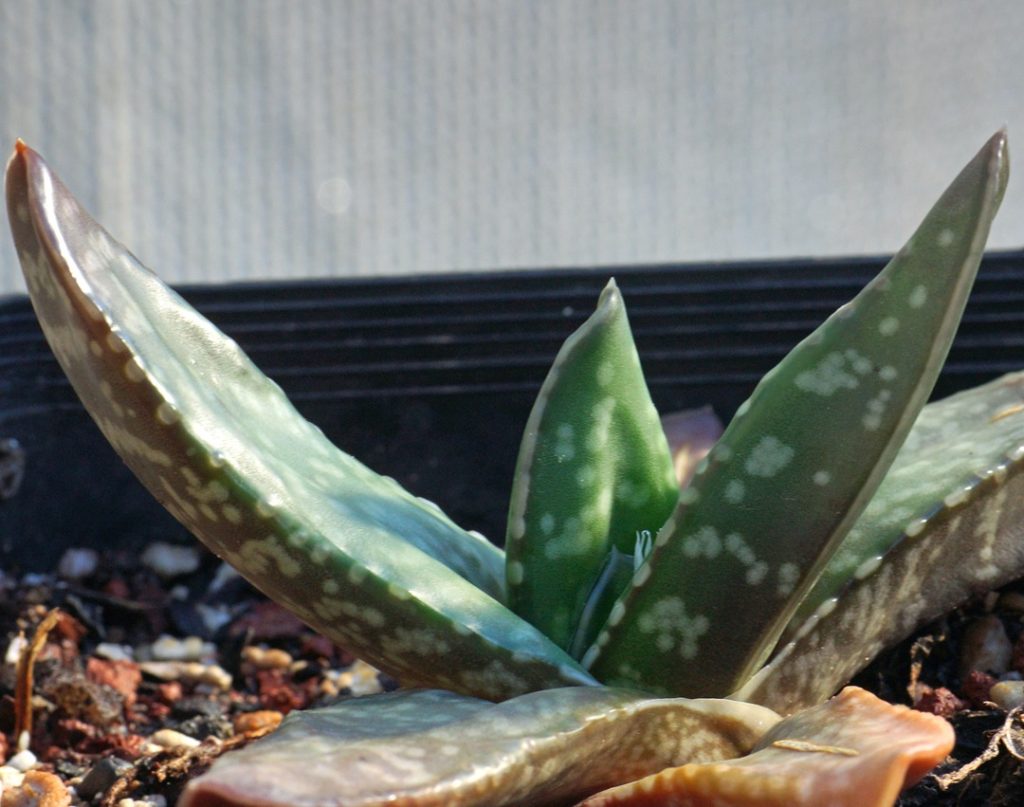
Gasteria polita is a small, solitary succulent that can reach a height of up to 8 inches. It has triangular, ascending-spreading leaves that are dark-mottled green in color. The flowers are pinkish and appear in summer.
Gasteria pulchra
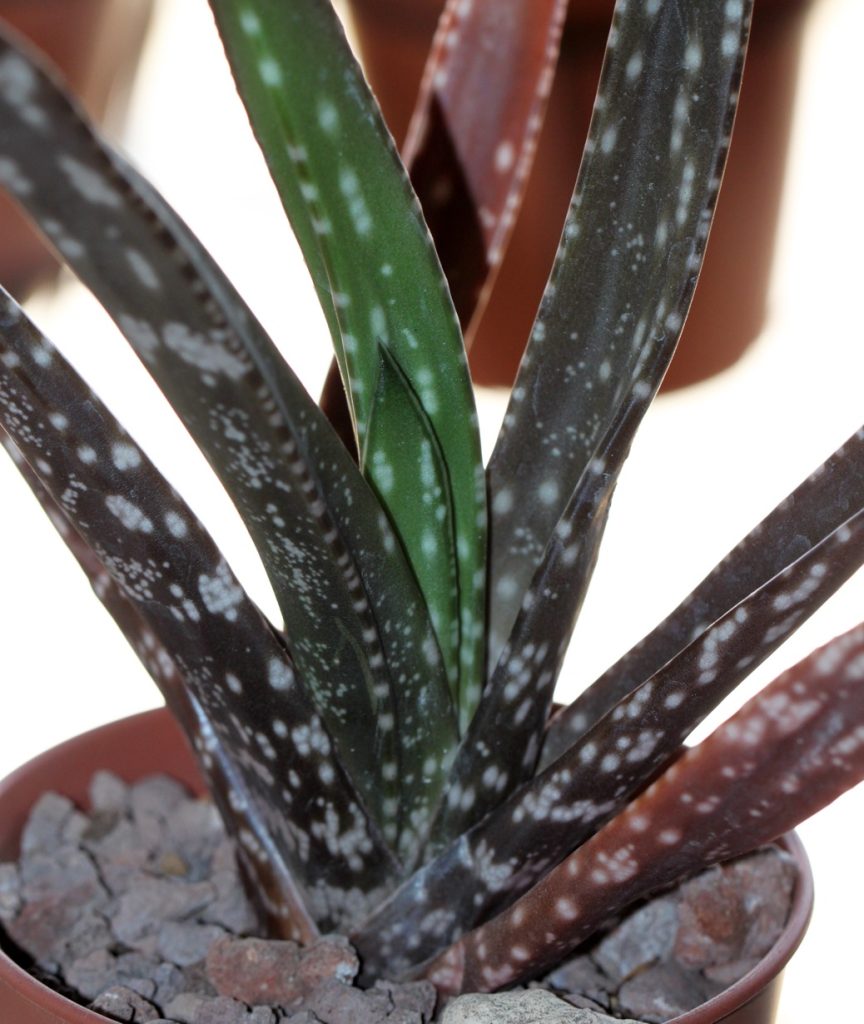
Gasteria pulchra is an upright, solitary or offsetting shrubby succulent with narrow, finger-like, marbled foliage. It forms a tight clump and can vary in leaf size, shape, marking, and growth habit.
Gasteria rawlinsonii
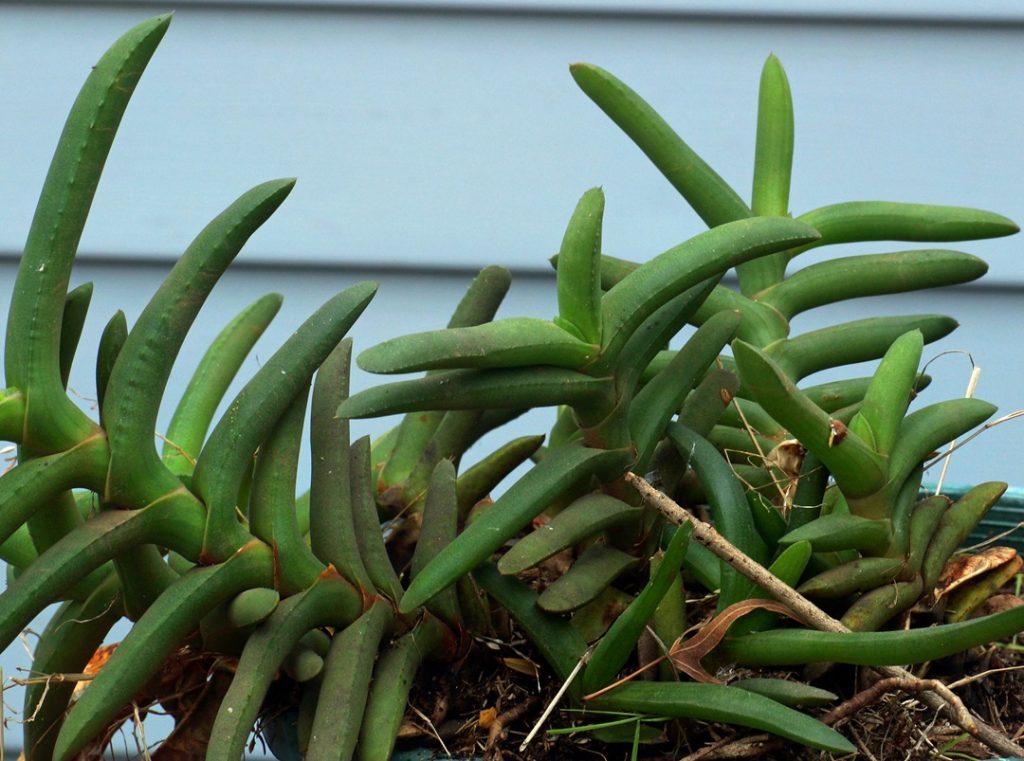
Gasteria rawlinsonii is a shrubby succulent that grows as solitary specimens or forms small groups. It can reach heights of up to 250 mm and form clusters up to 700 mm in diameter. The leaves are curved, sickle-shaped, and about 4.7-9.8 inches long and 1-1.4 inches wide. They are dark green with dense white spots arranged in obscure transverse bands. The inflorescence is a raceme, up to 16 inches long, with hanging flowers that have a tubular shape, ranging in color from reddish-pink to cream.
Gasteria tukhelensis
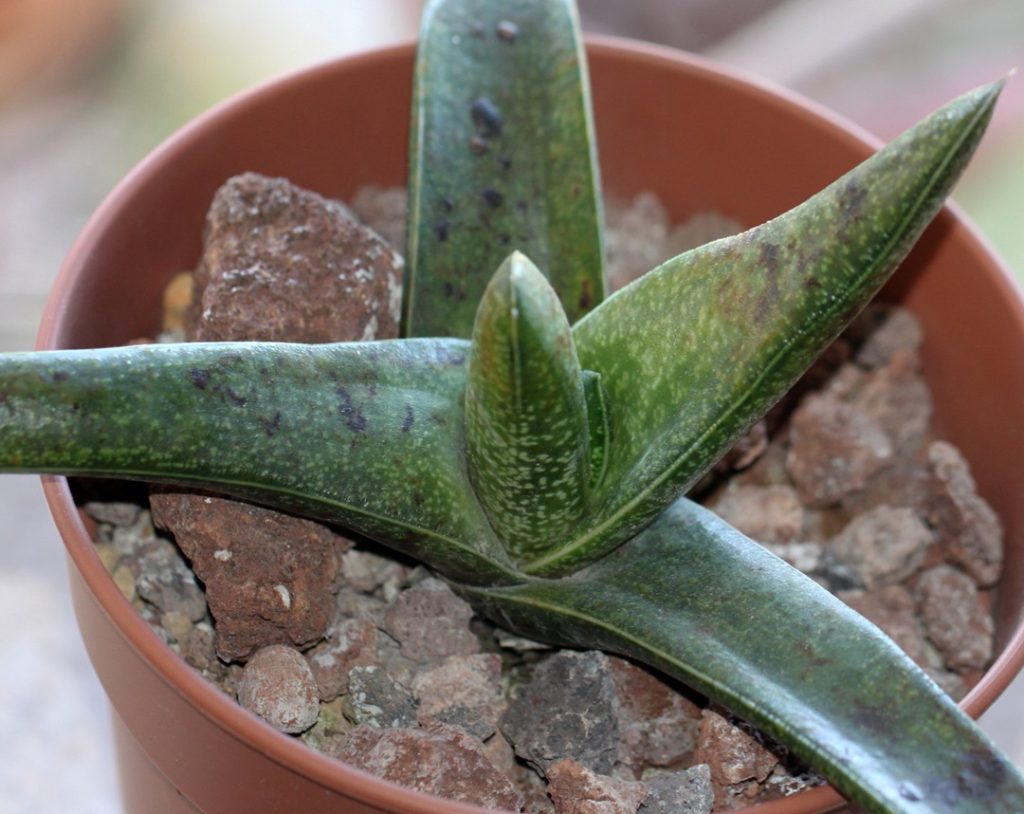
Gasteria tukhelensis is a stemless succulent that forms clusters up to 28 inches in diameter. It has triangular-shaped leaves that curve like a sickle and are densely spotted with obscure transverse bands.
Gasteria vlokii
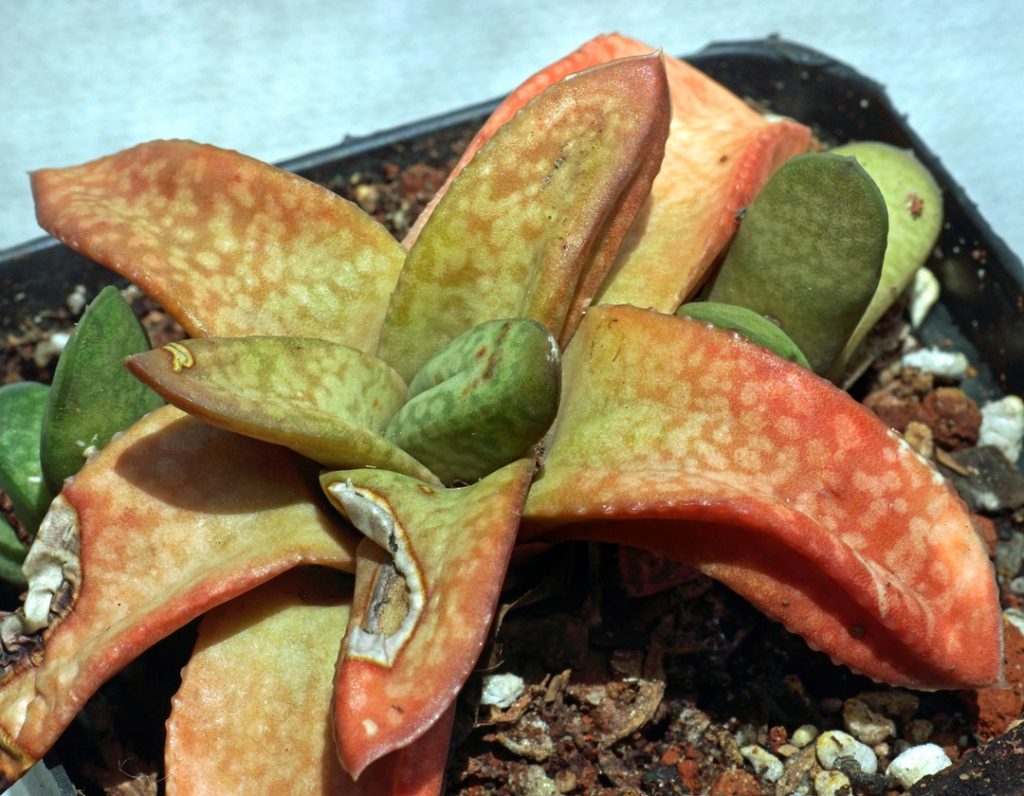
Gasteria vlokii is a stemless succulent that forms dense rounded clusters up to 5.5 inches in diameter. The leaves are belt-shaped, ranging from 2-4 inches long and 0.8-1.2 inches wide at the base. They are curving like a sickle and have a dark green color with obscure transverse white spots. The leaf margins are sharp with small teeth, and the leaf ends can be rounded or acute with a small point.
How to Care for Gasteria Types
Gasteria succulents are easy to care for and make wonderful potted plants. Here are some tips to help you keep them healthy and thriving.
Light
Gasteria varieties can tolerate shade better than other succulents, making them great for indoor growing. If you choose to keep them indoors, place them in a well-lit spot. For outdoor growth, ensure they receive partial sunlight rather than direct sunlight throughout the day. While some varieties can handle full sun, they generally prefer bright light without direct exposure.
Water
The key is to water Gasteria only when the soil is completely dry. During winter, reduce watering but don’t stop altogether. These plants are resilient and can handle some neglect.
Soil
Opt for a cactus and succulent-specific soil mix or create your own. Avoid using regular garden soil or potting soil, as they are not suitable for Gasteria.
Climate
Gasteria types can withstand heat and humidity quite well. The minimum temperature they can tolerate is around 40°F (4°C).
Fertilizing
Feed your Gasteria during the growing season using a specialized cactus and succulent fertilizer. Alternatively, a diluted amount of tomato fertilizer can also work. Fertilize every two months and stop during winter.
Repotting
It’s recommended to repot your Gasteria every year in spring. This is because the plant produces new roots annually, while the old roots die off. By pruning the old roots and transplanting yearly, you ensure better water and nutrient absorption.
Pests and Diseases
Gasteria varieties may develop small black spots, but these are not contagious or harmful to the plant. They often appear even on healthy Gasteria. However, be cautious of overwatering and providing inadequate light, as these can lead to harmful fungal infections. Treat any fungus with a suitable fungicide. Additionally, common succulent pests such as mealybugs and aphids may infest Gasteria, usually indicating insufficient light.
Propagating Gasteria Succulents
- Identify the Pup: Gasteria succulents often produce small offsets, also known as “pups,” that can be separated from the mother plant. Look for the pups that have formed near the base of the plant. They will typically be smaller and have their own set of roots.
- Gather Tools: Prepare the necessary tools before starting the propagation process. You will need a sharp, sanitized knife or gardening shears for separating the pup from the mother plant.
- Sanitize the Tools: It is essential to sanitize your cutting tools to prevent the risk of infection. Clean the knife or shears with rubbing alcohol or a mix of water and bleach. Rinse them well and allow them to dry before use.
- Prepare a Suitable Pot: Choose a small-sized pot with drainage holes for planting the separated pup. Ensure the pot has well-draining soil or use a cactus and succulent-specific soil mix.
- Remove the Pup: Gently and carefully separate the pup from the mother plant using the sanitized knife or shears. Make sure the pup has its own set of roots intact. If necessary, you can gently wiggle the pup back and forth to loosen it from the base.
- Let the Pup Callus: Place the separated pup in a dry, shaded area and let it sit for a few days to allow the cut end to callus over. This helps to prevent rot and infection.
- Plant the Pup: Once the pup has callused, plant it in the prepared pot with well-draining soil. Insert the roots of the pup into the soil, making sure it stands upright. Gently press the soil around the roots for stability.
- Provide Appropriate Care: Place the newly potted pup in a location with bright but indirect sunlight. Avoid direct sunlight, as it may scorch the young plant. Water the pup sparingly, allowing the soil to dry out between waterings. Overwatering can lead to root rot.
- Monitor and Maintain: Keep an eye on the newly propagated pup and ensure it receives the right amount of light, water, and appropriate temperature conditions. Adjust the care as needed to meet the specific requirements of Gasteria succulents.
- Patience and Growth: As the propagated pup establishes its roots and grows, it will develop into a mature Gasteria succulent over time. Provide regular care and watch as it flourishes into a beautiful plant.
Remember, propagating Gasteria succulents can be an enjoyable process but requires patience. Not all pups may successfully mature into fully grown plants, so it’s best to propagate multiple pups to increase the chances of successful propagation. With proper care and attention, you can enjoy the satisfaction of growing new Gasteria succulents from their pups.
